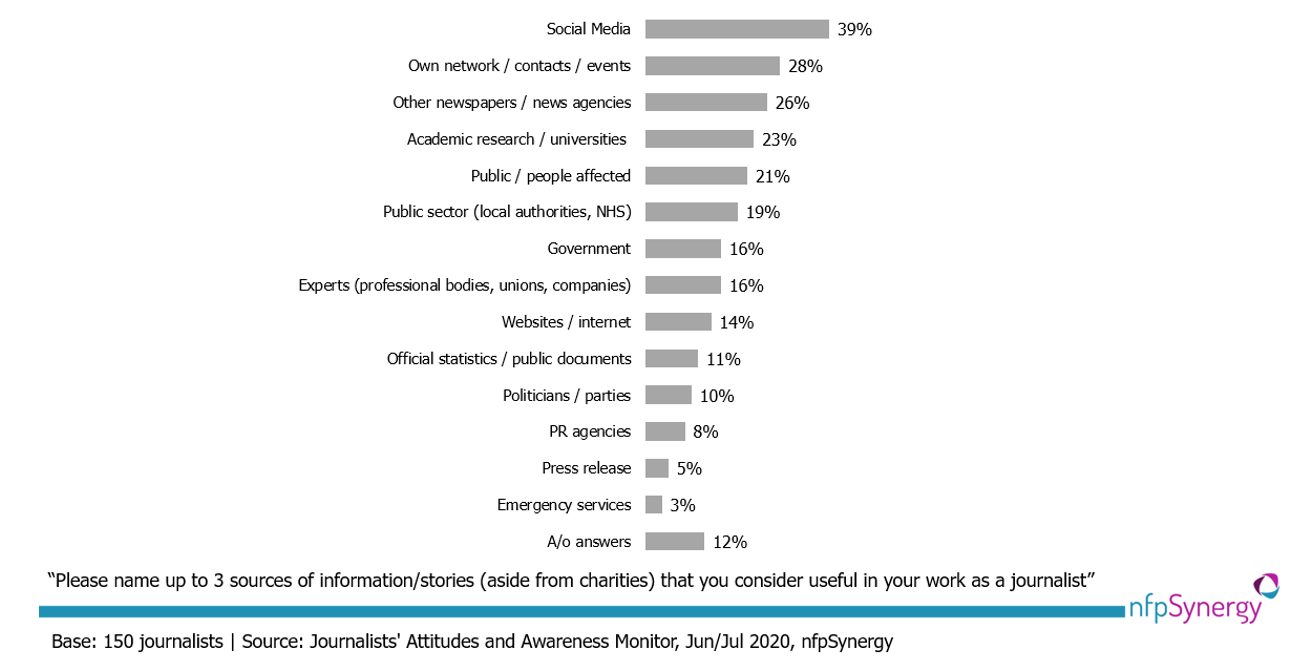Takeaway 1: Journalists see the charity sector as vital, but overcrowded
Let’s start with the positives. In 2019 we asked 167 journalists (all of whom had recently covered a charity story) about their opinions towards the sector and 99% of respondents said they ‘strongly agreed’ or ‘agreed’ that charities play a vital role in society. Furthermore, 93% of journalists polled were in agreement that charities make a real difference in society. For charities looking to engage with the media and get their stories heard there are encouraging signs that the media is both receptive and interested in hearing about their work.
However, the slightly more sobering fact remains that charities are seen to operate in an overcrowded sector. Half of journalists we contacted agreed with the statement that there are too many charities operating at the moment, with only a quarter actively disagreeing with that sentiment. Whilst there are positive signs therefore that avenues and platforms exist within the media for charity stories to be told, our research indicates that exploiting those avenues may prove difficult within an overcrowded sector.
Takeaway 2: In 2020 Covid-19 dominated the news agenda
It is hardly going to come as a surprise that media coverage in 2020 was centered around the pandemic. Last summer we asked 150 journalists what they were most concerned about. Two thirds of journalists said they were most concerned with the outbreak of Covid-19, whilst 43% said they were most concerned with the quality of NHS services. For charities up and down the country hoping to reorientate the media agenda away from singular issues such as Brexit that dominated so much of the previous five years, the pandemic certainly postponed such hopes. However, with the largest immunization programme now in full swing perhaps 2021 will be the year in which those aspirations are realised…
Takeaway 3: In 2021 media attention will likely ‘open up’ but the legacy of the pandemic looks set to remain
So what will happen to media attention in 2021? We asked journalists in the summer of 2020 what they thought charities should be focusing on in the post covid world and whilst the emphasis seemed to have shifted away from the specific health implications of the pandemic, journalists attached a lot of importance to the legacy of the pandemic. Mental health, poverty and inequality, social care and fundraising were all themes frequently mentioned by journalists. As one BBC journalist put it, the focus should be on the ‘long term physical and mental impact of coronavirus – the fallout could last decades.’
This is an encouraging sign first and foremost that journalist’s engagement with the charity sector will expand beyond coverage of the immediate responses to the pandemic. Charities ought to be aware though that whilst media attention is set to become less dominated by singular national issues, the legacy of the pandemic is likely to remain entrenched and so being aware of, and attuned to, that legacy will be important in getting traction with journalists.
Takeaway 4: Social media is seen as the most useful source for a charity story
With the media set to become more receptive to a wider range of stories in the coming year, it is worth questioning what the most effective ways to engage with journalists is. In summer we asked journalists what sources of information are most useful in their work (beyond direct contact with charities). Social media came out on top with 39% of journalists listing it as an important source of information whilst more direct forms of contact such as a press release were only seen as useful by 5% of journalists. Social media is of course an integral part of most modern charity operations and what this latest research demonstrates is that having an active, engaging and informative online presence is fundamental to engaging journalists.
Figure 1: Useful sources of information for journalists
Takeaway 5: Journalists are attuned to the financial challenges faced by charities
In a year in which spotlighting specific issues has been difficult as so much has been eclipsed by the pandemic, it is promising to see that journalists are increasingly aware of the financial strains facing charities. As mention in point three, numerous journalists mentioned funding as a key area of focus for charities post Covid-19. We dug into this a little further and found that just over half of journalists (55%) listed ‘finding more funding sources’ as a key future priority, an increase of 21 percentage points since we asked this question in autumn 2017.
Our research with the general public in the summer last year also indicated that public awareness of the financial difficulties faced by charities was reasonably good with half of the public (49%) saying they were extremely or very concerned about the financial implications of the pandemic on the charity sector. Whilst the highest levels of concern amongst the public was directed towards to small businesses (62%), what last year’s research ultimately shows is that both journalists and the general public are relatively switched-on to the challenges faced by the sector and are likely to engage with discussions around problems and remedy’s to fundraising shortfalls. For charities this is an encouraging sign that a media strategy that engages with such issues will likely get traction amongst the public and journalists.


